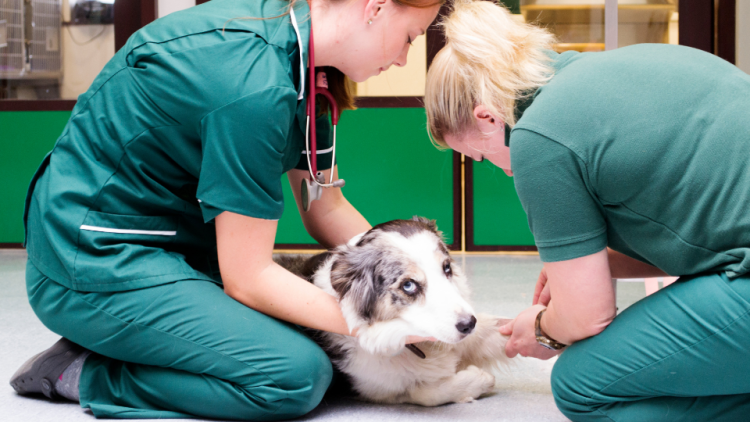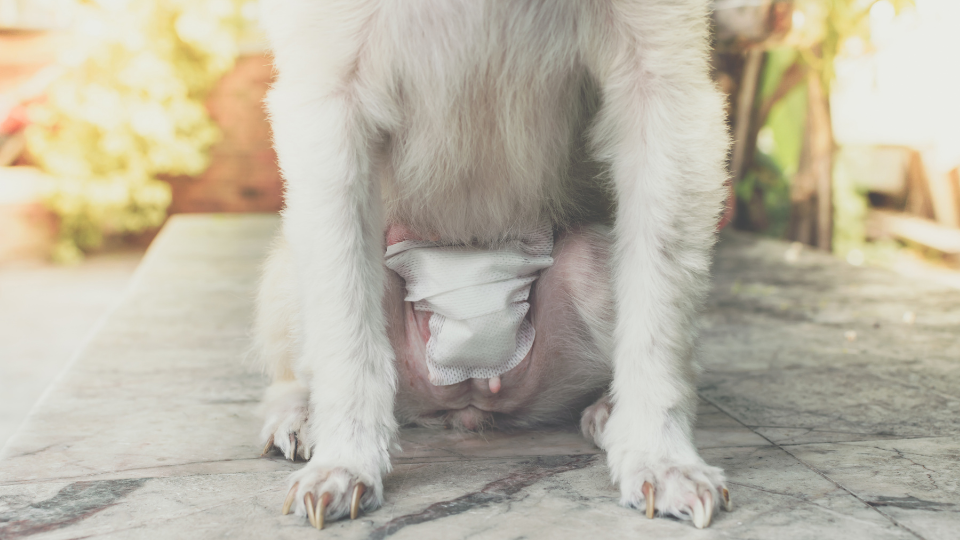Pyometra is one of the most serious conditions that affect female dogs. It is caused by the uterus filling with pus and, if left untreated, it can be fatal. The good news is, there is a way to prevent your dog from getting this disease.
Read on to find out more about pyometra in dogs, including what causes it, how you can tell if your dog has pyometra, and what you can do to prevent it.
Table of Contents:
- What is pyometra in dogs?
- What causes pyometra in dogs?
- What does pyometra in dogs look like?
- How to diagnose pyometra in dogs
- How to treat pyometra in dogs
- How to prevent pyometra in dogs
- Key Takeaways
Pro Tip: To most pet parents, dogs are like family members. Pet insurance is there to offer financial protection so you can give your companion the essential care they need should an accident or illness occur.
What is pyometra in dogs?
Pyometra is a serious uterus (womb) infection in dogs. In dogs with pyometra, the uterus becomes filled with pus and the infection can spread systemically resulting in sepsis. If left untreated, pyometra can be fatal.
Pyometra usually occurs in older, sexually intact dogs but can also occur in unspayed dogs of any age. The condition develops as a result of hormonal changes in the dog’s reproductive tract combined with introduced bacteria, most commonly E. coli, and usually begins two to eight weeks after the last heat cycle (estrus).
Types of pyometra in dogs
There are two different types of pyometra in dogs: open and closed. In open pyometra, the cervix remains open, allowing the pus to drain out. In the second type - closed pyometra - the pus collects and the bacteria release toxins that are absorbed into the bloodstream. Closed cervix pyometra is typically more difficult to diagnose and results in a more severe illness than the open type.
In rare cases, a spayed dog will develop a specific type of pyometra called a stump pyometra. After spaying, a small womb stump remains inside the dog, in which an infection can develop. Since ovary hormones are necessary for this condition to develop, any pup with stump pyometra also has a small piece of ovary tissue inside her which was not obvious at the time of spay.
What causes pyometra in dogs?
Following estrus, the progesterone levels remain high for about eight to 10 weeks and thicken the lining of the womb in order to prepare for pregnancy. If pregnancy doesn’t happen for several heat cycles, the lining will continue to thicken until cysts form inside it. The cystic lining will start secreting fluids that create a favorable environment for bacteria growth.
The bacteria usually travel up from the dog’s vulva when it’s open during heat. If the uterus is normal, the bacteria won’t be able to survive inside it. However, when the wall of the uterus is cystic, there are ideal conditions for the bacteria to grow. In addition, the elevated progesterone levels inhibit the ability of the muscles in the uterine wall to contract, which means that the bacteria that enter the womb can’t be expelled.
Other factors that increase the risk of pyometra infection in dogs include:
- Administration of progesterone-based drugs to delay estrus or treat certain reproductive conditions
- Estrogen injections for prevention of pregnancy
- Inflammation of the uterine wall after giving birth (postpartum metritis
- Urinary tract infections
- Poor hygiene and fecal contamination into the vagina
What does pyometra in dogs look like?
The symptoms will depend on whether the dog has open or closed pyometra. In the case of open pyometra, there might be an unusual, foul-smelling vaginal discharge. This can be accompanied by lethargy, depression, anorexia, and fever.
Dogs with closed cervix pyometra typically become severely ill very quickly. They might show signs like severe listlessness, depression, and anorexia, as well as diarrhea, vomiting, and swollen or bloated abdomen. The toxins released from the uterus might also affect the ability of the kidneys to retain fluid, which might result in increased production of urine and increased thirst.
Other symptoms of pyometra may include:
- Pale, grayish gums
- Weight loss
- Licking of the private parts
- Lack of appetite
- Panting
- Reluctancy to move (in latter stages)
- Collapse
Unfortunately, by the time owners notice any signs of illness, the condition is usually in an advanced stage, which means that the dog requires immediate medical attention.

How to diagnose pyometra in dogs
Vets diagnose pyometra based on the dog’s clinical signs and an ultrasound examination of the uterus.
Your veterinarian will likely ask about when your dog’s last season was and how she has been acting recently. They will also perform physical examinations and check your dog’s abdomen to check for swelling and might perform laboratory tests.
Dogs with pyometra infection usually have elevated globulins and white blood cell counts, as well as a low concentration of urine. However, these changes can be present in any animal with a bacterial infection and are not enough to make a definitive diagnosis of pyometra.
If the dog’s cervix is closed, the vet will perform an ultrasound scan or take x-rays images of the abdomen in order to identify signs of pyometra, such as uterine enlargement.
How to treat pyometra in dogs
Surgery is the most common and preferred treatment for all types of pyometra infections and the only option for closed cervix pyometra. The procedure involves removal of the uterus and the ovaries and is high-risk because if the pus spills during removal, it can be very dangerous for the patient.
The pet will need to take antibiotics for two weeks after the surgery, as well as IV fluids. Because the procedure is quite complex, she will also need to be hospitalized for one to two days after surgery. Your dog will also require a post-operative check about two weeks after surgery to ensure adequate healing of the wound site.

Once your dog is ready to go home, you’ll need to make sure she stays calm and gets plenty of rest. You’ll also need to make sure that she eats regularly, drinks enough fluids, and takes the prescribed medications. Your pet will probably need to wear a protective suit or buster collar to prevent her from licking at the wound.
The earlier an infected womb is removed, the higher the chances of a dog’s survival. Unfortunately, pyometra and complications resulting from the high-risk operation can be fatal.
Pro Tip: The cost of surgery is expensive because the procedures are complex and require extensive veterinary expertise. Luckily, the right pet insurance plan can help. A comprehensive pet insurance provider will assist in covering the expenses so that you can focus on your dog’s full recovery.
Alternative treatments for pyometra in dogs
Prostalgin injections are an alternative option for treating open-type pyometra, but only if the condition is caught in the early stages. This treatment takes about one week and requires hospitalization and monitoring.
It should be noted that Prostalgin injections are only recommended for valuable breeding animals, as they come with considerable risks and potential long-term complications.
The injections can cause side effects including vomiting, restlessness, defecation, panting, abdominal pain, and salivation. These adverse effects usually occur within minutes after administration and can last for several hours.
The improvement of clinical signs should follow after about 48 hours, so if your dog is severely ill, she needs to receive immediate life-saving therapy.
Prostalgin injections will cause the womb to contract, so it’s possible for the womb to rupture and spill the infected pus into the abdominal cavity, resulting in peritonitis, which is a serious, life-threatening condition.
If you are planning to breed your dog, it is crucial to do so in the estrus cycle immediately after the infection, or the chances of re-infection can be as high as 77%.
Can pyometra in dogs be treated with antibiotics?
No, pyometrea can not be treated with antibiotics alone. The amount of pus in the uterus prevents any antibiotic that's administered orally or subcutaneously from penetrating the infection. Even if it does, the dog’s underlying medical conditions would lead to a recurrence after treatment.
The chances of successful resolution without a surgical procedure or Prostalgin are very low. Without prompt medical treatment, the toxins from the bacteria can lead to kidney failure, toxemia, dehydration, and, in some cases, death. If the cervix is closed, it’s possible for the womb to rupture, spilling the pus into the abdominal cavity.
Your vet will recommend the best course of treatment depending on the specific situation for your dog.
Veterinary costs for pyometra treatment
The cost of treatment will depend on the severity of the infection. Prostalgin treatment usually costs from $200 to $500, depending on the duration of the treatment and the amount required.
The cost for ovariohysterectomy surgery is higher, as the treatment is more intensive and risky. The procedure including all surgical and anesthetic fees will cost about $2,000 to $8,000 depending on location and if the surgery has to happen after hours.
Antibiotics for a two-week course cost about $60 to $150, whereas IV fluid therapy can cost between $150 and $300.
Prognosis and recovery
If you see any signs of pyometra infection, be sure to take your dog to the vet ASAP. Pyometra is a serious condition that requires immediate medical treatment.
Starting treatment in the early stages increases the chances of a favorable outcome. The outlook for dogs after ovariohysterectomy surgery is usually full recovery with no risk of recurring.
In animals treated with Prostalgin injections, the infection can cause long-term damage to the womb. Pregnancy rates decline after a dog has had pyometra, sometimes to as low as 50%, so vets only attempt Prostalgin treatment in exceptional situations.
How to prevent pyometra in dogs
Pyometra is one of the main reasons why veterinarians advise pet parents to get their dogs spayed if they are not planning to breed them. The risk of pyometra goes up with each heat cycle your pet has. The earlier you spay them the less likely they will experience this disease. Spaying your pets when they are young is much less expensive than having to spay them if they get pyometra and can save you a lot of stress and thousands of dollars.
Key Takeaways
- Pyometra is an infection of the uterus. It is a very serious condition that affects female dogs and, if left untreated, it can be fatal.
- Treatment for pyometra includes emergency surgery to remove the uterus, antibiotic medications, and intravenous fluids.
- The sooner a dog with pyometra is treated, the better her chance of survival and recovery.
- Spaying your dog will prevent pyometra.
- Pyometra requires emergency medical care, so be sure to call your vet right away if your dog is showing symptoms.
- Pet insurance covers illnesses, accidents, emergency care, and more with up to 90% reimbursement on vet bills.
